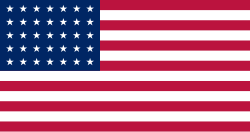
This is a list of military units raised by the Commonwealth of Kentucky, a neutral southern border state with dual competing Unionist and Confederate governments during the American Civil War, for service in the Union Army. Southern both geographically and culturally, an estimated 125,000 Kentuckians served as Union soldiers; almost quadruple the number of Kentuckians serving as Confederate soldiers (numbered at 35,000-45,000). The list of Kentucky's Confederate Civil War units is shown separately.